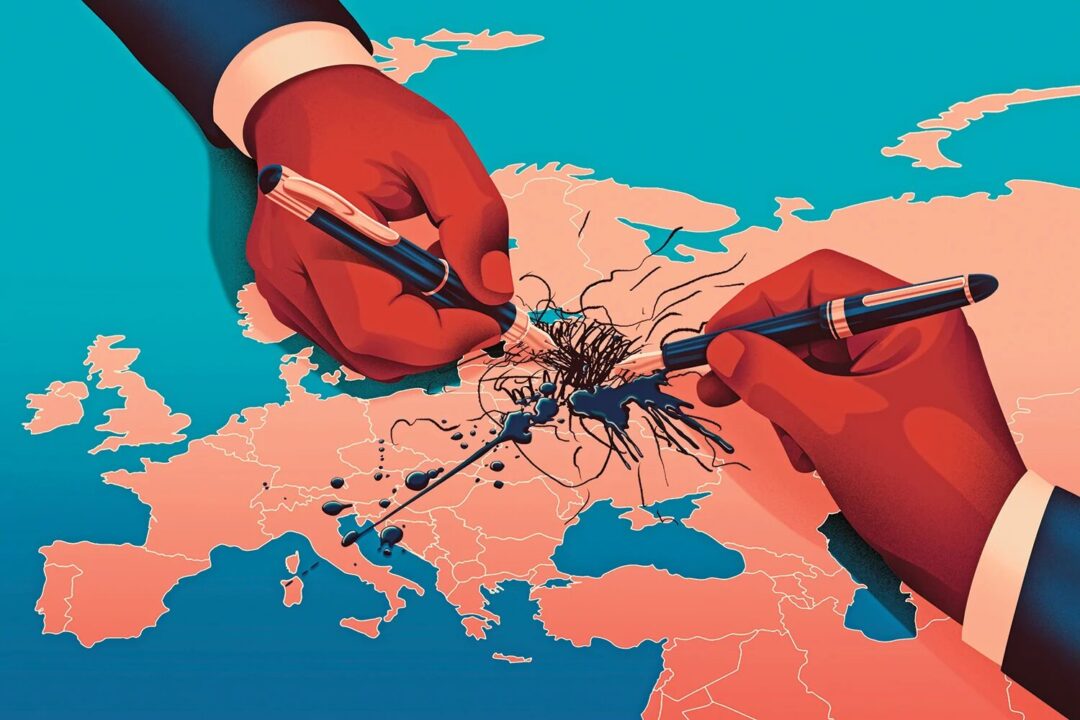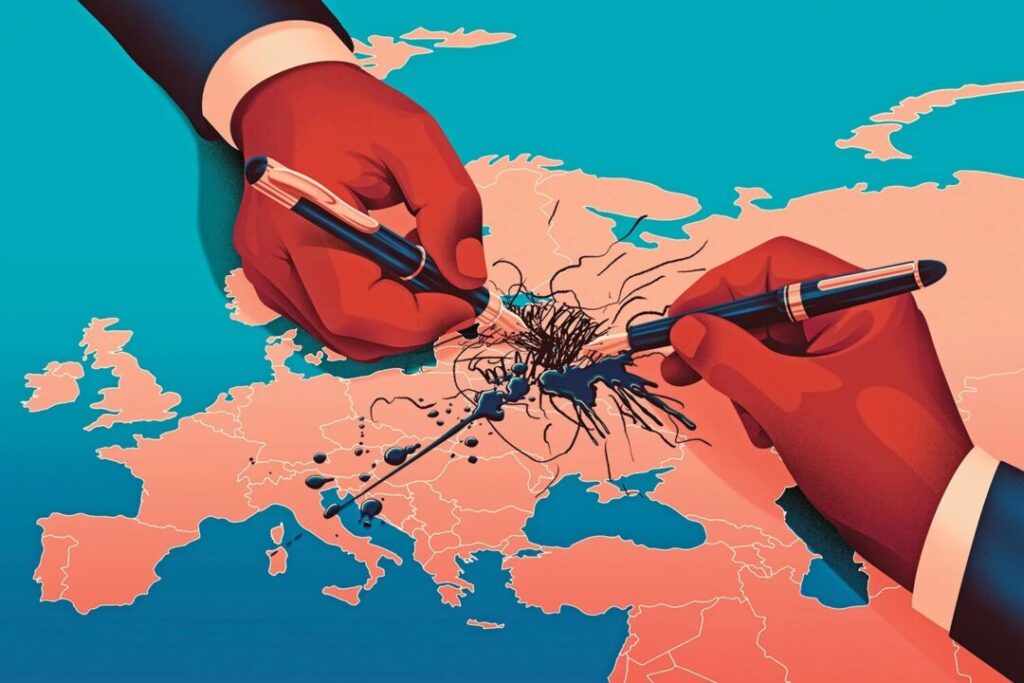The Art of Drawing line: Where Geopolitics meets brawls

Boundaries, which define the limits and restrict the jurisdictions between the countries, become significant challenges if they are drawn without considering the historical, socio-cultural, economic, resource allocation, developmental, and geographical perspectives. A boundary establishes the territory and legitimises the sovereign’s claim. However, overlying claims due to disagreements on the marked areas result in boundary disputes, often leading to prolonged conflicts that test diplomatic acumen and international norms. These disputes pose significant challenges for the countries as they demand intricate strategies. These disputes may continue over decades and may cause grave damages if not addressed at the right time. However, the problem lies in how to address it effectively.

Boundary dispute over time has become a great gambit. Resolving them is challenging, especially as using swords does not lead to sustainable solutions. The use of the military, though, may be beneficial for a short-term solution; however, in the long term, it fails as you require continuous support of arms, ammunition, food, and human resources to be present in the boundary at all times to prevent the future encroachments which are not practically feasible and military might of one can easily be displaced by the other if they have gained more powerful ammunitions. It can only be used for defensive purposes. Furthermore, it fails to convince the international community as a legitimate territory for an enduring period as it involves non-recognition by the neighbour and thus the international community, it will often appear to be a forceful acquisition or a military-held property rather than a legitimate property. The mutual recognition and resolution of disputes by addressing the root cause is necessary to ensure international acceptability and enduring legitimate holding of territory. Additionally, the forceful acquisition of territory leads to prolonged tensions, especially as it often leads to resistance movements seeking secessions. At the same time, military deployment tends to create fear, insecurity, and hatred among the people, failing them to integrate within the country. Furthermore, this also breaches international law provisions of sovereignty and territoriality enshrined in almost all international treaties while influencing other countries to do the same. This exacerbates international bodies and other countries to impose sanctions for the breach of international law and human rights violations and limits the country’s involvement in international trade and investments. This is seen in the case of Jammu and Kashmir, where the use of the military failed to resolve the dispute. If unprepared, the encroachers have entered the Indian side. Though we cannot deny that it helps in defending the country, the presence of the military and the grave human rights violations have caused more debacles than providing a long-term solution to this issue. This mainly can be witnessed with the numerous wars and ceasefire violations between India and Pakistan, from the 1965 war to Siachen Glacier to Kargil, and frequent ceasefire violations; military solutions have failed to achieve long-term peace in this state.
Thus, resolving boundary disputes through peaceful methods is significant for ensuring stability, fostering cooperation, and guaranteeing enduring peace between nations. For this, diplomacy is the main route to resolve boundary disputes. Countries can efficaciously use diplomatic discussions to foster mutual interests, address grievances, and work towards mutually acceptable solution. This is generally a confrontation and resolving disputes between the countries at contestation. The diplomatic talks between India and China over the Line of Actual Control (LAC) have primarily reflected diplomacy. Additionally, these countries can opt for mediation, which involves resolving disputes with the help of a mediator. The mediator, an impartial third party, helps the parties in dispute come to a resolution. The mediator helps find common ground, promotes discussion, and suggests potential fixes. The willingness of both parties to engage and make concessions is necessary for mediation to be voluntary. This was seen in the case of the Ethiopia – Eritrea land boundary settlement case of 2000, where the United Nations helped them to reach a consensus.
Additionally, the countries may also opt for arbitration. It involves presenting the dispute to an independent and non-partisan tribunal or arbitrator. Both parties agree in advance to abide by the arbitrator’s decision. The formal arbitration process resembles a court proceeding, with each side presenting evidence and arguments. The arbitrator’s decision is binding and enforceable. India and Bangladesh went for a maritime dispute resolution in the Permanent Court of Arbitration in The Hague in 2014, and they resolved their dispute over fishing rights and natural resources by clarifying the maritime boundaries. Furthermore, these conflicts can also be settled legally by framing the case in international courts like the International Court of Justice (ICJ). These courts can hear disputes from counties and render legally binding decisions based on international law. The Nicaragua vs Columbia case hearing was held in the ICJ on the maritime boundaries dispute and helped settle it.
The contesting nations can also establish joint boundary commissions as cooperative entities to discuss and settle disputes. These commissions focus on the technical and administrative facets of the dispute, establish borders, and carry out cooperative surveys. While the US and Canada established the International Boundary Commission to maintain international boundaries, the India-Nepal Joint Boundary Commission 1981 addressed, surveyed, managed, and demarcated borders. Furthermore, many regional organizations help to resolve boundary disputes. These organizations provide structures and forums for dialogue, mediation, and arbitration and use regional solidarity and shared interests to promote peaceful resolutions. For instance, the African Union helped in resolving the Sudan-South Sudan boundary dispute. They provided the framework and forum for dialogue and ensured regional stability and peaceful resolution. Additionally, they may also opt for conciliation. In conciliation, both Arbitration and mediation are involved. A commission for conciliation includes impartial specialists who look into the conflict, pinpoint the contentions, and propose a resolution. Although the commission’s proposals are not legally obligatory, they propose a structured framework for additional discussions and possible resolution. Argentina and Chile entered a papal mediation in the late 1970s, with the procedure headed by Pope John Paul II. This ultimately transformed into a formal treaty in 1984, settling the claims over the Channel Beagle.
Boundary disputes can be resolved by countries negotiating and signing treaties or agreements that define the boundaries accurately and provide guidelines for resolving conflicts in the future. This is the most conventional way of resolving any conflict. As treaties are enforceable contracts it help to avert future hostilities, are typically the outcome of extensive diplomatic efforts. The Land Boundary Agreement 2015 between India and Bangladesh resolved the long-standing boundary dispute between the two countries and helped them demarcate their land boundaries, especially as the exchange of enclaves took place.
As often boundary disputes are a product of insecurities and distrust, countries should adopt Confidence-building measures that help reduce distrust between the countries and improve their relationship can bring them to dialogue. These measures are taken to ease the tensions and build trust between the disputing parties. These measures include information sharing, military transparency, joint exercises, and other cooperative activities that promote mutual understanding and reduce hostilities, improving the environment for future dialogue and collaboration.
Lastly, involving the general public and specialists in the resolution process can yield insightful information and promote a feeling of legitimacy and ownership. Expert consultations bring in technical information and unbiased analysis to inform the settlement process, while public consultations give affected groups a chance to express their concerns and wishes.
The Galwan Valley standoff refers to the grave confrontation between Indian and Chinese troops that occured on June 15, 2020, in the Galwan Valley region of Ladakh, along the Line of Actual Control (LAC). The Moonlight massacre resulted in deadly casualties on both sides, marking the first lethal skirmish between the two countries in several decades. The incident sharply raised tensions between China and India, prompting military and diplomatic discussions to defuse the situation and prevent further hostilities. While this confrontation reflected the defensive role of the military to protect the territory, it clearly showed that simply the military hold over it does not mean that the territory would not be contested. This standoff, therefore, requires more than defensive military tactics to resolve the dispute. For this purpose, Beijing and New Delhi need to initiate a high-level diplomatic dialogue that includes confidence-building measures between the two countries. This may include hotlines between military commanders, regular meetings, joint patrols to combat transnational crime, etc. They must also commit to peace resolution of boundary disputes, sign Conflict Prevention Treaties, and engage in long-term peace mechanisms. Both India and China have engaged in at least 20 rounds of military talks and 13 rounds of foreign office-led discussions which have led to disengagement at five points: Pangong Tso’s north and south banks, patrolling points 15 and 17A in the Gogra-Hot Springs Area, and Galwan. However, the Chinese military deployment is getting thicker instead of becoming thin, which has jeopardized confidence-building measures. This is an area that Beijing needs to work on this.
The Kalapani boundary dispute in 2020 escalated after India inaugurated a new road linking the Lipulekh Pass to Kailash Mansarovar, passing through territory claimed by Nepal. This move reignited past boundary disputes, demanding the need to reinterpret boundaries. Nepal asserted that the line should follow the western bank of the Kali River, placing Kalapani within its borders, while India insisted that the border lies farther east, on the ridgeline that leads to the Lipulekh Pass. This aggravated tensions between the countries. To resolve conflict, simply deploying an army could be interpreted as a move toward the dominance of a larger country over a smaller one and can invite International resentment. Instead, negotiations and diplomatic concessions can be used, while a Joint Boundary Commission can also be instituted to resolve boundary disputes peacefully. They may go to the ICJ or set up a tribunal if needed.
Thus, the resolution of boundary disputes requires a multifaceted approach. History has proved that the military might not provide enduring, sustainable peace. While it is an excellent short-term defensive tactic, with Soft power replacing hard power in the international arena, it shall invite tensions rather than resolve them. Instead, peaceful means like diplomacy, dialogue, mediation, arbitration, agreement, etc, can. However, they take years, offer more sustainable settlements, address the root causes of disputes, and foster mutual recognition and respect. Countries must engage in these peaceful means to resolve disputes as it ensures not only the legitimacy and recognition of their borders but also to maintain regional and global peace.


Leave a Reply